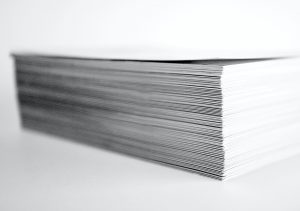Analyzing 5 Resume Myths with A Christmas Story

“You’ll shoot your eye out!” While they might come from a good place just like this famous line in A Christmas Story, these five common resume myths are actually holding you back. Make sure they don’t intimidate you when writing your resume!
By: David Hartley | Contributor for Let’s Eat, Grandma
What’s not to love? The “Italian” leg lamp, Chinese food for Christmas, and an official Red Ryder, carbine action, two-hundred shot range model air rifle!
Most iconic of all is the classic line, “you’ll shoot your eye out!” Now, Ralphie does shoot himself in a freak accident, but most people would argue that “shooting your eye out” was a myth to dissuade Ralphie from wanting a BB gun in the first place.
Tired of not landing interviews?
Get our free 3-step guide to writing better resume bullet points, featuring 70 ideas for metrics you can use!
Reminds me of some of the questions my clients have asked me about “things they’ve heard” about resumes – which turn out to be myths.
Wait, you didn’t think we were leaving 2021 without another movie tie-in? It’s never too late to learn about what’s okay to add to your resume by looking at some common resume myths.
Myth 1: “Your resume can only be one page” or “A resume can be any number of pages”

Your resume can be longer than one page, (but make sure it’s no longer than two). Photo by ron dyar on Unsplash
This is the No. 1 question I receive from clients. It seems pedantic, but HR managers and recruiters pay attention to resume length to get an understanding of the candidate. A resume is supposed to be a highlight of your best skills and achievements, not a bibliography of your entire career. Think about your resume as an elevator pitch that makes an impression, and not a two-hour presentation.
With that being said, a resume should be a maximum of two pages. (With the exception of academic CVs, federal resumes, and very rarely, the absolute highest of all high-level executives.)
But who qualifies for a two-page resume? When I work with clients, I often use the rule of 10+ years of relevant experience may require two pages. Does that mean that if you have nine years of experience you shouldn’t use a two-page resume? Not necessarily. If you have some truly spectacular achievements that you want to highlight, then two pages may be necessary.
However, one word of caution: If you do decide that two pages are right for you, be sure to fill at least a page and a half. If you have just a little bit of text spilling over to the second page, it’s best to reformat to fit it all on one.
Myth 2: “An ATS will reject your resume if you don’t have enough keywords/the wrong font/the wrong format”

A common resume myth is that you should stuff your resume with keywords — but this strategy will turn your resume into a jumbled mess that no one with read. Photo by Niccolò Chiamori on Unsplash
Let’s address one thing right off the bat: Applicant Tracking Systems don’t reject resumes without human input, they simply store and sometimes rank them.
It all depends on how the recruiter has set their ATS up. And, regardless of ATS compliance or keywords, your resume will still be in a recruiter’s system and available for them to view if they choose to.
Nevertheless, this resume myth has caused some people to panic and write “ATS resumes” that don’t actually impress the humans who hire.
Now with that techno-jargon out of the way, let’s talk keywords. I want to stress that keywords are important. But they shouldn’t distract focus from the story of what you did or who you are as an employee.
I often use the term “word salad” for bullet points that focus too much on technical keywords and terms and not enough on the result or achievement within the bullet point. As you write your resume, you’ll be placing keywords in the Areas of Expertise and the Summary of Qualifications as well as the bullets. So always remember to take a step back and reread the bullet or sentence for clarity. Is it easy to understand what you’re talking about at first glance? If not, you’ve let this common resume myth get to you and have written for the “robot” instead of a human. Don’t write a word salad!
As far as font and format are concerned, there are a few rules to remember to optimize your resume design for an ATS including not using columns, charts, boxes, or uncommon fonts. But these rules are to ensure that the amazing information on your resume is parsed correctly by an ATS so that it will come up in search results, not to stop an ATS from outright rejecting it.
Don’t let the common resume myth of “beating” an ATS impact your resume. Just focusing on writing a resume that highlights your achievements and, with just a little tweaking for each job, keywords will find their way onto the document naturally rather than forcibly.
Myth 3: “Functional resumes can hide career gaps or help career changers”

Watch out for confusing resume formats, as they’ll hide your accomplishments rather than spotlight them. Photo by ThisisEngineering RAEng on Unsplash
This common resume myth has been more apt than ever with job seekers transitioning to new career paths. When you’re changing industries or jumping back into the workforce after a gap, a functional resume that highlights skills and hides your job experiences sounds like a good choice, right? Wrong!
Most recruiters can’t stand the popular “functional resume” format. With all your accomplishments listed above only bare listings of your jobs, it takes all of your bullet points out of context, makes your key info harder to read, and can make it look like you’re hiding something.
You have nothing to hide. Writing a resume for a new industry is all about leveraging transferable skills that align with your job search, which you can showcase in your previous jobs. While you may not have all the technical skills for the job you are applying to, you certainly have some of the interpersonal, leadership, and collaboration expertise they are looking for.
Take the time to look back beyond your industry-specific language in your past jobs and highlight those skills that will transfer to the industry with bullet points that show impactful results.
As far as a career gap goes, there are some better ways we can begin to bridge the gap. Part of what we can do is ensure that your keywords are relevant and align with the job you’re applying to.
The other strategy to employ is how we highlight the achievements within the document. Focus on the most relevant and recent experience and those gaps won’t seem as glaring on the document.
You can also focus on explaining the gap in your cover letter rather than hiding it. And for some smaller gaps, you can just remove months from the position listings on your resume. Learn how to use those strategies and more here.
Myth 4: “Resumes can’t have color”
Instead of this common resume myth, the real rule should be: A resume shouldn’t have too much color or too many color types. It’s okay to have color on a resume since different colors have different impacts – several of our resumes use color. However, if you do decide to add a splash of color (I can’t emphasize splash enough), choose only one color that matches your personal brand and creates a feeling that represents you.
With clients I have worked with, I have added blue dividers for sections or blue section headers to catch the eye. Color can work in your favor if you use it strategically. Be sure to carefully analyze your document and use your best judgment as you add color to your resume.
Myth 5: “You need a ‘modern’ template to stand out”
With all the modern and graphic templates available on the internet, it’s tempting to think you need a fancy format that you believe will catch the eye of a hiring manager or a recruiter, such as those on Canva or Etsy.
I stick to the adage “if it ain’t broke, don’t fix it.” Rather than utilizing bar graphs, timelines, or icon to display information, it’s actually better to highlight your achievements simply with impactful results and metrics. Recruiters don’t really care how fancy your resume looks – they just want to be able to find your key information easily!
It may seem like a cut and dry method, but sticking to strong metrics that make your resume stand out context-wise is the stronger choice rather than relying on fancy graphics that only catch the eye briefly.
Don’t let these common resume myths drag you down into an unsuccessful job search. Focus on what works, and remember to take all that you learned about resume writing into 2022 to ensure you succeed in landing interviews!
Ready for more job search help?
Sign up for a free Senior Writer Resume Critique to see what's holding you back from landing interviews. One of our top professional resume writers will give you personalized feedback on the top 3 items you can improve based on our expert practices!
